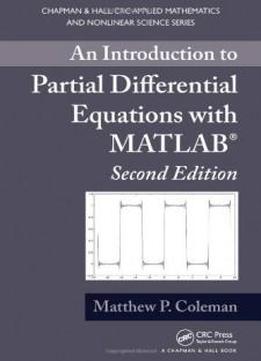
An Introduction To Partial Differential Equations With Matlab, Second Edition (chapman & Hall/crc Applied Mathematics & Nonlinear Science)
by Matthew P. Coleman /
2013 / English / PDF
5 MB Download
An Introduction to Partial Differential Equations with
MATLAB
An Introduction to Partial Differential Equations with
MATLAB®
®, Second Edition
, Second Edition illustrates the
usefulness of PDEs through numerous applications and helps
students appreciate the beauty of the underlying mathematics.
Updated throughout, this second edition of a bestseller shows
students how PDEs can model diverse problems, including the flow
of heat, the propagation of sound waves, the spread of algae
along the ocean’s surface, the fluctuation in the price of a
stock option, and the quantum mechanical behavior of a hydrogen
atom.
illustrates the
usefulness of PDEs through numerous applications and helps
students appreciate the beauty of the underlying mathematics.
Updated throughout, this second edition of a bestseller shows
students how PDEs can model diverse problems, including the flow
of heat, the propagation of sound waves, the spread of algae
along the ocean’s surface, the fluctuation in the price of a
stock option, and the quantum mechanical behavior of a hydrogen
atom.
Suitable for a two-semester introduction to PDEs and Fourier
series for mathematics, physics, and engineering students, the
text teaches the equations based on method of solution. It
provides both physical and mathematical motivation as much as
possible. The author treats problems in one spatial dimension
before dealing with those in higher dimensions. He covers PDEs on
bounded domains and then on unbounded domains, introducing
students to Fourier series early on in the text.
Suitable for a two-semester introduction to PDEs and Fourier
series for mathematics, physics, and engineering students, the
text teaches the equations based on method of solution. It
provides both physical and mathematical motivation as much as
possible. The author treats problems in one spatial dimension
before dealing with those in higher dimensions. He covers PDEs on
bounded domains and then on unbounded domains, introducing
students to Fourier series early on in the text.
Each chapter’s prelude explains what and why material is to be
covered and considers the material in a historical setting. The
text also contains many exercises, including standard ones and
graphical problems using MATLAB. While the book can be used
without MATLAB, instructors and students are encouraged to take
advantage of MATLAB’s excellent graphics capabilities. The MATLAB
code used to generate the tables and figures is available in an
appendix and on the author’s website.
Each chapter’s prelude explains what and why material is to be
covered and considers the material in a historical setting. The
text also contains many exercises, including standard ones and
graphical problems using MATLAB. While the book can be used
without MATLAB, instructors and students are encouraged to take
advantage of MATLAB’s excellent graphics capabilities. The MATLAB
code used to generate the tables and figures is available in an
appendix and on the author’s website.











